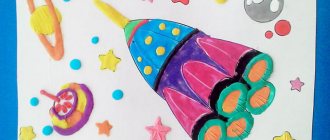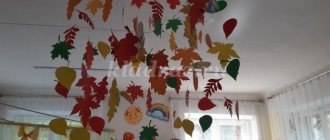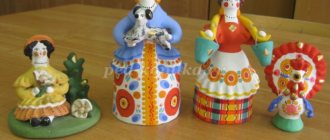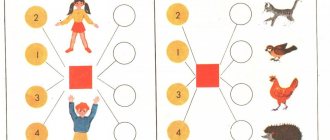Fine art lesson in kindergarten on the topic: “Spoon painting (Khokhloma)”
Summary of a lesson on art activities in the senior group
Topic: “ Spoon painting (Khokhloma)”
Program content:
-Continue to introduce children to Khokhloma products. Introduce a new element - curl. Strengthen the ability to draw berries (with a stamp), leaves, grass. Teach children to make a pattern in a circle. Convey the color of the painting, the combination of color, background and elements of the plant pattern. -Develop aesthetic perception, sense of color, composition. -Cultivate love and respect for working people.
Demonstration material:
exhibition of Khokhloma paintings, images of Khokhloma products.
Handout materials:
wooden spoons, gouache, brushes, cotton swabs, napkins, stands for brushes, cups for water.
Audio material:
song “Our Khokhloma” by Yu. Chichkov, song “Russian Spoons”
Progress of the lesson:
Russian folk music sounds. Khokhloma products
are placed on the tables in front of the children Educator: Who needs dishes for porridge-okroshka, a miracle dish and cups, spoons?
Come, honest people, to our exhibition. Don't pass by, be our dear guests at our wonderful exhibition. Admire the products of great masters. Look at these products guys. How can they be called in one word? - Dishes. — Are the dishes here the same? - No. - Here are the cups, here are the spoons, the samovar and the ladle. - What is this dish similar to? Pick up one product at a time and look at it carefully. How is this dish similar? — It is made of wood, identical elements of the pattern (curls, grass, leaves, a twig with berries), the pattern is made on a black or yellow background. - What is the name of this dish? Who has already guessed? -Khokhloma dishes Yes, Golden Khokhloma itself has come to you! A golden grass grew on a spoon, a flower blossomed on a bowl, a cranberry ripened on a ladle. There is no shame in putting such dishes on the royal table. How did this wondrous wonder appear - “golden Khokhloma”? An old legend tells: once upon a time there lived a man in the Nizhny Novgorod forests, on the banks of a quiet river. We don’t know who he is or where he came from. That man carved wooden bowls and spoons and painted them so that
they seemed to be made of pure gold.
The king found out about this and became angry: “Why don’t I have such a master in my palace?! Give it to me! Immediately!" He tapped his staff, stamped his foot, and sent soldiers to take the craftsman to the palace. The soldiers set off to carry out the royal order, but no matter how much they searched, they could not find the miracle master. He went to God knows where, but first he taught local peasants how to make “golden” dishes. In each hut cups and spoons sparkled with gold. A lot of “golden” dishes were sold at a fair in the village of Khokhloma. This is how the name “golden Khokhloma” was born. Let's remember once again what plant elements the Khokhloma pattern consists of - Berries, leaves, curls, bushes. (I demonstrate in the pictures) - Look, there are scarlet bunches of rowan, and a ripe strawberry, and curls of herbs and leaves. And most importantly - a shimmering golden background, which makes the product more elegant and festive - Guys, I noticed the basket that stands in the corner. Maybe someone forgot her. Let's look into it (take out spoons). - Someone left us these spoons. Maybe the craftsmen who brought us their products? Look, the spoons are not simple, but wooden. But they just don’t have a pattern, and they don’t look exactly festive. Guys, do you want to become real master artists of Khokhloma and paint these spoons. And now, everyone sat down at the tables together, everyone looked at me. (put on aprons) - What colors will we need to make the pattern? (black, red, green) (showing samples of painted spoons)
- Guys, look at the samples of spoons and tell me what elements make up the pattern on these spoons? - The pattern consists of a branch with berries, leaves, curls and grass. - What is the main rule when making a pattern?
(the elements of the pattern should be located rhythmically, at the same distance, repeating the elements evenly)
.
— First you need to draw a curved branch with the end of the brush. Then berries and leaves are depicted on the branch (leaves can be drawn with the end of a brush, by dipping, and berries can also be drawn with the end of a brush or by poking)
.
Then, near the berries and leaves, you can draw blades of grass - with (arched)
. But you can also draw berries with a stamp (cotton swab). Watch how I paint the spoon. In the center of the spoon we draw a curl, one after another. From the curl, I draw blades of grass with the tip of the brush. But let’s draw the berries with a stamp. - Now you will become masters - artists of Khokhloma and decorate wooden spoons with patterns. Now let's get to work. Children’s independent work is accompanied by music (the song “Our Khokhloma” by Yu. Chichkov is played.) When the children draw berries and leaves, advise them to add small details to the berries at their ends (dots or “antennae”, and veins (black) on the leaves). Analysis of children's works. - Now look and find the spoons that are most similar to Khokhloma ones, select and show the most beautiful spoon. Tell us about it: what color it is, what colors it is painted with, what berries are on the pattern, why this spoon is better than others. - Guys , you tried very hard, now our fair will be replenished with Khokhloma spoons. - The Khokhloma painting, like a witch’s, asks for a fairy-tale song And nowhere in the world are there such inflorescences Of all the wonders more wonderful than our Khokhloma And now I’ll ask the perky musicians to come out here. - Well, take the spoons apart, Start dancing with us. Song “Russian Spoons”.
Features of the technology
It is customary to paint wooden products with Khokhloma: toys, dishes, etc. The finished product can be given as a gift or kept for home decoration. Before you start painting, you need to prepare all the materials and tools. To work you will need:
a wooden board for cutting food or any other item for the base;- adhesive;
- gouache or other paints;
- egg white;
- sheets of paper;
- pencils;
- brushes for painting of different thicknesses;
- varnish for fixing the pattern;
- paint brush.
After the above list and Khokhloma painting stencils have been collected, you can begin to work.
Step-by-step master class:
- Coat the wooden base well with egg white and let it soak in a little.
- Prepare a sketch drawing on a separate sheet.
- Cover a cutting board or other object with gold paint and wait until it dries completely.
- Using a pencil, carefully redraw the drawing from the sheet onto the base.
- Color all the ornaments of flowers and berries red.
- Using a thin brush, add curls, leaves and veins.
- Mark the boundaries of the patterns and outline them thicker.
Even though the base was painted gold, the final design should give the impression that the background is still black. The finished product should be allowed to dry, then check and complete the missing elements and green grass. Secure the design with a thin layer of varnish.
Main differences
All types of Khokhloma paintings on household kitchen utensils have their own characteristics. It is from them that experts or simply knowledgeable people can talk about the creation technique. The name “Khokhloma” is one of the most popular among paintings. Not only experienced artists, but also preschoolers can learn to draw step by step. Khokhloma painting patterns for beginners include:
- Grass patterns - a line curved to the side. To get it, you must first press the brush in the center, and then, moving it to the side, gradually reduce the pressure and gradually reduce the thickness.
- Leaf is one of the simplest patterns. Mirror blades of grass are drawn, curved outward. All empty spaces are filled with paint of the same color.
- A curl curled like a snail is less common because it is more difficult to draw. It is important to maintain equal pressure on the hand.
- Droplet - the brush is placed at the base of the bristles and slowly turns 180 degrees, slightly moving forward and lifting off the surface. Drawing droplets helps train your hand to press correctly.
- A bush is a few droplets arranged in the form of a fan. A small dot is placed at its base.








